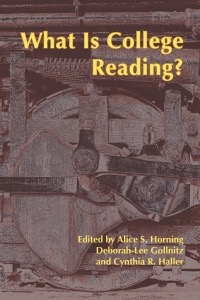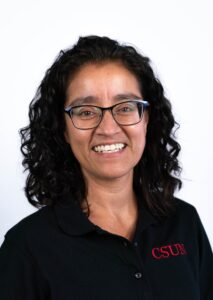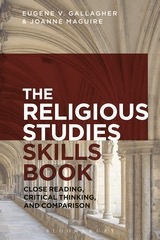reading
Select an item by clicking its checkbox
I was asked for pictures of me while teaching in the classroom. An organization I’m part of wanted them for one of their platforms and I obliged. I asked a student to use their phone to take pictures of me during one of our class sessions. I asked them ...
Date Reviewed: December 10, 2019
Gallagher and Maguire wrote The Religious Studies Skills Book for undergraduate students taking religious studies courses. Recipients of the American Academy of Religion’s Award for Excellence in Teaching and longtime Wabash Center affiliates, Maguire and Gallagher draw on the breadth of their experiences as scholar-teachers to craft an accessible book that covers the basics – and more.
They dispel myths, like the assumption that teaching about religions in public universities is unconstitutional, and they clarify common confusion, including the distinction between studying theology and religious studies. They also offer insights into what makes the study of religion so compelling and worthwhile:
Students of religion are in a field unlike any other. The field has interdisciplinary breadth and global and historical depth that can’t be found elsewhere on campus. Many students come to the academic study of religion expecting personal spiritual development. Although that might be an accidental outcome of exposure to ideas in any course, teachers tend to be strongly interested in developing students’ skills and knowledge, goals achieved in part by reading, observation, and discussion that brackets personal judgement and biases . . . If a single introductory course in religious studies teaches nothing else, it will at least show you that there are many other ways to understand the world. (69-70)
I quote this passage at length because it exemplifies one of the two most important features of this book: the authors write to and for students. They do this from the first to the last page. I never felt like they overlooked the student to speak to a colleague. Midway through, I flipped back to the title page and wrote, “How many of us write for this audience? They’re taking students seriously!” It’s refreshing, and it is one aspect of the book that would make me want to assign it.
The book’s other great strength is how the authors model what they expect students to learn. Most chapters include explicit examples. The chapter on comparison offers lengthy examinations of how comparison works using excerpts from sacred texts (Matthew and Science and Health with Key to the Scriptures) and scholarly ones (definitions of religion). In some places, the authors anticipate students’ observations, and in others, they expand their scope. For example, they note fairly obvious similarities between the gospel and Science and Health, and then they expand the comparison through a series of questions about authorial intent. In addition to the explicit examples, Gallagher and Maguire build an argument through the arrangement of the book’s chapters and draw on evidence from scholarship on teaching and learning. The companion website provides more general information and additional exercises, too.
My main concern is how the book can reach its intended audience. Ideally, students in introductory courses would read and absorb the Skills Book. Realistically, the motivated majors in a third-year seminar will be carrying copies with dog-eared pages, and, years from now, graduate students learning how to teach will be lucky to find a copy with some dedicated major’s marginalia.

What is College Reading?
Date Reviewed: January 18, 2019
Co-published by CSU Open Press
What is college reading? As college teachers we may assume that it is a process of comprehension, analysis, synthesis, and evaluation. But, as this edited volume overwhelmingly demonstrates, that is often not what it is for college students. How then can college teachers help students practice advanced reading skills? The problem is compounded by the fact that even college teachers who actively want to encourage students to read may unwittingly discourage advanced reading skills by, for example, giving reading quizzes in class (as discussed by Mary Lou Odom in this volume). This edited volume is a great resource for anyone wishing to engage questions about how to improve college reading.
Some chapters provide useful practical suggestions. For example, Chris Anson shows how to formulate reading log prompts that require students to engage with the underlying ideas in the reading. Other chapters describe exercises such as in-class annotations (Davies) and says-does columns (Huffman). The volume also contains several insightful discussions of other factors influencing college reading that are more difficult to address, but no less important. For example, some of the authors observe that reading, which we may think of as an individual activity, is a “complex sociolinguistic task” (Hollander et al., 59), and “a collective and holistic enterprise” (Maloy et al., 71). Brian Gogan provides a thoughtful reflection on reading in relation to “threshold concepts” (concepts that students need to grasp in order to move forward in a given disciplinary context). College teachers may use these insights to make reading part of building an intellectual community in the class.
The chapter by Young and Potter discusses how students are taught to read in K-12, where students are commonly given a decontextualized passage and then tested on their ability to understand inferences at the level of sentences or paragraphs. These students also commonly learn that for each question asked about the text, there is one correct answer in a multiple-choice format. They receive comparably little training in the advanced reading skills required for college, such as learning how to place a particular text into a connected web of texts that make up an ongoing disciplinary conversation, or asking their own higher-order questions and working with others’ questions that do not have a single “correct” answer. When students start college, therefore, they will commonly think of reading as looking for answers in a decontextualized excerpt; they are not accustomed to looking instead for interesting, productive problems in a web of texts (as also discussed in the afterword by Sullivan and Tinberg).
Other authors discuss the importance of instructors connecting reading with writing, drawing on both the writing-to-read and reading-to-write conversations (Anson; Freedman). Some chapters refer to the by now widely known finding that the majority of students do not do what their instructors think they do when completing a research paper assignment, and how to address the implications of this for formulating new types of writing assignments (Horning; Young and Potter). Related to this, Laura Davies points out in her chapter that students who write poorly are usually referred to the university’s writing center, rather than asked about their reading skills, which underlie their writing. Several chapters also touch on how reading might be given a stronger institutional footing through, for example, being explicitly incorporated into writing-across-the-curriculum initiatives (Odom), linking courses (Sturtz et al.), or providing a reading-across-the-curriculum community on campus (Hollander et al.).
In sum, as Leonora Freedman observes in her chapter, stronger responses to the problem of how to teach college reading skills can lead to increased student engagement as well as increased faculty morale. This edited volume is a very good place to start. It deserves a wide readership among college faculty and administrators, and this goal will no doubt be made easier by the fact that the publishers have made it free to download at wac.colostate.edu.

